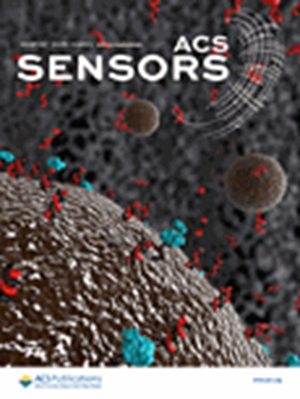协同反应促进剂金纳米粒子-具有高效电化学发光的限制性配位聚合物用于神经系统疾病生物标志物的敏感检测。
IF 9.1
1区 化学
Q1 CHEMISTRY, ANALYTICAL
引用次数: 0
摘要
本研究以2,2′-二硫代二苯甲酸(DTBA)为发光配体,Zn2+为金属节点,Au纳米颗粒(AuNPs)作为Au- s键约束在DTBA上的协同反应促进剂,合成了高效电化学发光(ECL)配位聚合物Au- zn -DTBA,用于构建灵敏检测神经系统疾病生物标志物多巴胺的生物传感器。与不添加助反应促进剂的Zn-DTBA ECL体系相比,Au-Zn-DTBA的ECL强度提高了4倍,这是由于Zn-DTBA中的AuNPs可以促进共反应物K2S2O8产生丰富的硫酸盐自由基SO4•-,从而显著提高了Zn-DTBA的ECL效率。因此,采用Au-Zn-DTBA/K2S2O8 ECL系统开发了一种用于多巴胺检测的超灵敏ECL生物传感器,其检测限低至0.41 nM,优于大多数先前报道的多巴胺生物传感器。这一策略显示了基于限制效应的协同反应加速器的巨大潜力,为提高ECL效率和扩大其在临床分析中的应用提供了一种新的方法。本文章由计算机程序翻译,如有差异,请以英文原文为准。
Coreaction Accelerator Au Nanoparticle-Confined Coordination Polymers with Highly Efficient Electrochemiluminescence for Sensitive Detection of Neurological Disease Biomarkers.
In this study, a highly efficient electrochemiluminescent (ECL) coordination polymer, Au-Zn-DTBA, was synthesized by employing 2,2'-dithiodibenzoic acid (DTBA) as the luminescent ligand and Zn2+ as the metal node as well as Au nanoparticles (AuNPs) as coreaction accelerators confined to DTBA via Au-S bonds for the construction of biosensors for sensitive detection of the biomarker of neurological disease, dopamine. Compared to the Zn-DTBA ECL system without a coreaction accelerator, Au-Zn-DTBA exhibits a 4-fold enhancement in ECL intensity, since AuNPs confined in Zn-DTBA could promote the coreactant K2S2O8 to produce abundant sulfate radicals SO4•- for significantly enhancing the ECL efficiency of Zn-DTBA. As a result, an ultrasensitive ECL biosensor employing the Au-Zn-DTBA/K2S2O8 ECL system was developed for dopamine detection, achieving a low detection limit of 0.41 nM and outperforming most previously reported dopamine biosensors. This strategy demonstrates the significant potential of coreaction accelerators based on the confining effect, offering a novel approach for increasing ECL efficiency and expanding its application in clinical analysis.
求助全文
通过发布文献求助,成功后即可免费获取论文全文。
去求助
来源期刊

ACS Sensors
Chemical Engineering-Bioengineering
CiteScore
14.50
自引率
3.40%
发文量
372
期刊介绍:
ACS Sensors is a peer-reviewed research journal that focuses on the dissemination of new and original knowledge in the field of sensor science, particularly those that selectively sense chemical or biological species or processes. The journal covers a broad range of topics, including but not limited to biosensors, chemical sensors, gas sensors, intracellular sensors, single molecule sensors, cell chips, and microfluidic devices. It aims to publish articles that address conceptual advances in sensing technology applicable to various types of analytes or application papers that report on the use of existing sensing concepts in new ways or for new analytes.
 求助内容:
求助内容: 应助结果提醒方式:
应助结果提醒方式:


